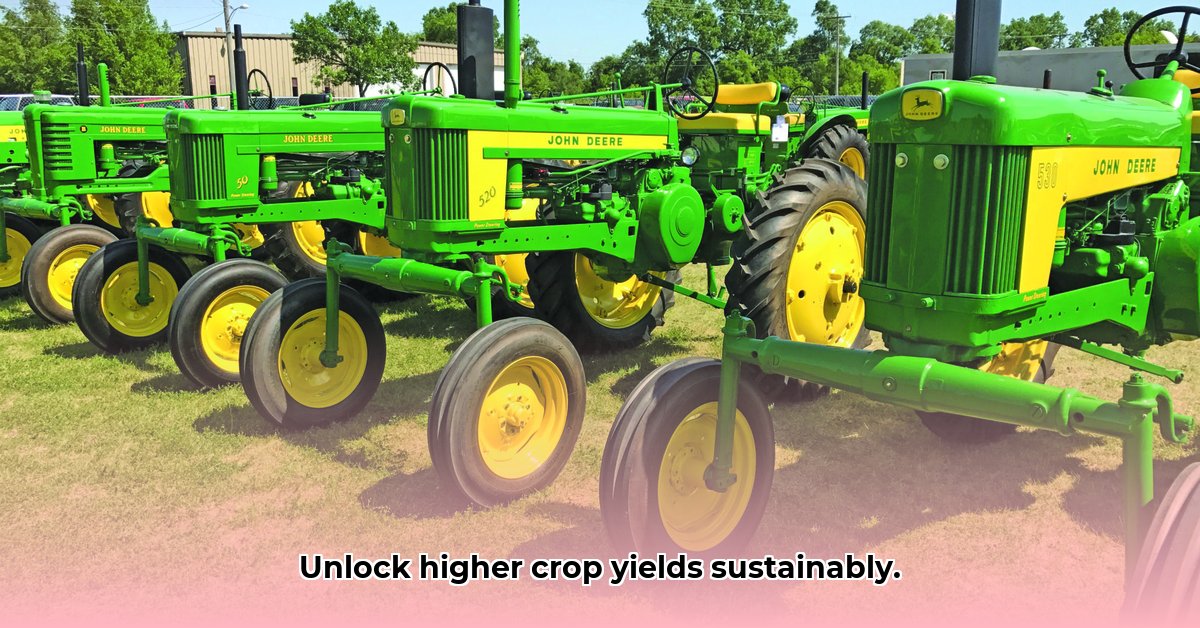
Choosing the right high-crop tractor is a pivotal decision for any farmer, significantly impacting both profitability and environmental sustainability. This guide compares leading brands, New Holland and John Deere, providing actionable insights for farmers of all sizes, dealers, and policymakers. For more information on John Deere's X-Series, check out this page.
New Holland vs. John Deere: High-Crop Tractor Showdown
New Holland and John Deere offer distinct high-crop tractor options catering to diverse farming operations. The optimal choice depends heavily on individual farm circumstances and long-term goals.
New Holland: The TS6 Series II tractors are known for their practical design and budget-friendly approach, making them well-suited for smaller farms or operations with tighter budgets. They provide a strong balance of power and functionality without the premium price tag of more technologically advanced models. They are reliable workhorses, ideal for consistent performance on a variety of tasks.
John Deere: John Deere tractors are synonymous with advanced technology and precision agriculture. Models often include cutting-edge features like Smart Apply and the autonomous GUSS system, promising substantial gains in efficiency and labor savings. While representing a significant upfront investment, the potential return on investment (ROI) can be substantial for large-scale operations.
Sustainability in High-Crop Tractor Technology
Both New Holland and John Deere are committed to sustainability, incorporating Tier 4B emission-compliant engines (engines that meet strict emission standards) for reduced environmental impact. However, John Deere further enhances sustainability through its precision agriculture technologies. These technologies not only boost farm efficiency but also contribute to sustainable farming practices by optimizing resource utilization and maximizing yields. Isn't minimizing environmental impact while maximizing profits a win-win scenario?
Making the Right Choice: Actionable Steps for Stakeholders
The decision-making process differs based on stakeholder perspectives.
For Small-Scale Farmers:
- Initial Assessment: Begin by thoroughly evaluating the value proposition of the New Holland TS6 Series II, focusing on its cost-effectiveness and versatility.
- Long-Term Planning: Explore financing options, including government subsidies and grants, to mitigate the initial investment cost.
For Large-Scale Farms:
- ROI Analysis: Conduct a comprehensive return on investment (ROI) analysis for John Deere's Smart Apply and GUSS systems, considering increased efficiency and potential yield improvements.
- Data Management: Invest in a robust data management infrastructure to effectively capture, analyze, and utilize the data generated by precision agriculture technologies. Effective data analysis is key to optimizing farm operations.
For Equipment Dealers:
- Diverse Inventory: Maintain a diverse inventory of both New Holland and John Deere tractors to meet the varied needs of your customer base, providing both cost-effective and technologically advanced options.
- Technology Partnerships: Cultivate strong relationships with technology providers to offer integrated precision agriculture solutions, positioning your dealership as a comprehensive resource for your customers.
For Policy Makers:
- Environmental Impact Assessment: Conduct thorough assessments to compare the environmental impact of different tractor technologies, focusing on emission levels and resource consumption.
- Incentive Programs: Develop policy incentives (e.g., tax breaks, subsidies) that encourage the adoption of Tier 4B tractors and precision agriculture technologies, promoting sustainability.
Navigating Technological Challenges: Risks and Mitigation
Advanced technologies, while offering significant benefits, present potential challenges.
| Technology | Potential Challenges | Mitigation Strategies |
|---|---|---|
| Tier 4B Emission Systems | Unexpected malfunctions; increased emissions | Regular maintenance; adherence to manufacturer guidelines; prompt issue resolution |
| Smart Apply System | Calibration errors; inaccurate application | Meticulous calibration; thorough operator training; data validation |
| GUSS Autonomous System | System malfunctions; crop damage; safety concerns | Redundant systems; pre-deployment testing; responsible operator oversight |
The Future of High-Crop Tractors
The future of farming will be shaped by advancing technologies and increasingly stringent environmental regulations. The continued adoption of autonomous systems like GUSS will transform the high-crop tractor market. Farmers who adapt to this evolving landscape, embracing new technologies and staying informed of regulatory changes, will be best positioned for success in a sustainable, data-driven agricultural future.
How to Compare John Deere and New Holland Tractor Total Cost of Ownership (TCO)
Understanding Total Cost of Ownership (TCO) is crucial for informed decision-making.
Key Considerations:
- Initial purchase price
- Maintenance and repair costs
- Fuel efficiency
- Resale value
Comparing the Brands:
While both New Holland and John Deere are industry leaders, their strengths differ. New Holland often excels in high-power applications, while John Deere offers a broader range, making them potentially more cost-effective for smaller operations. Consider the long-term implications, including maintenance and repair, when conducting your analysis.
Sustainability's Role:
Sustainability is a pivotal factor in long-term profitability. Analyze fuel efficiency, maintenance intervals, and repair costs. Efficient tractors translate to cost savings, reduced downtime, and reduced environmental impact. This is vital for sustainable farming practices.
Actionable Steps for Buyers:
- Define your needs: Assess your farming operations and identify essential tractor features and power requirements.
- Gather data: Research specific models, comparing specifications and prices. Supplement manufacturer data with independent reviews and comparisons.
- Calculate TCO estimates: Estimate annual operational costs, encompassing fuel, maintenance, and potential resale value.
- Explore financing: Investigate financing options and their influence on overall TCO.
- Test drive: Whenever feasible, test drive both brands to determine which model best aligns with your needs and preferences.
By conducting a thorough TCO analysis and careful consideration of your long-term needs, you can choose a high-crop tractor that optimally balances performance, sustainability, and cost-effectiveness.